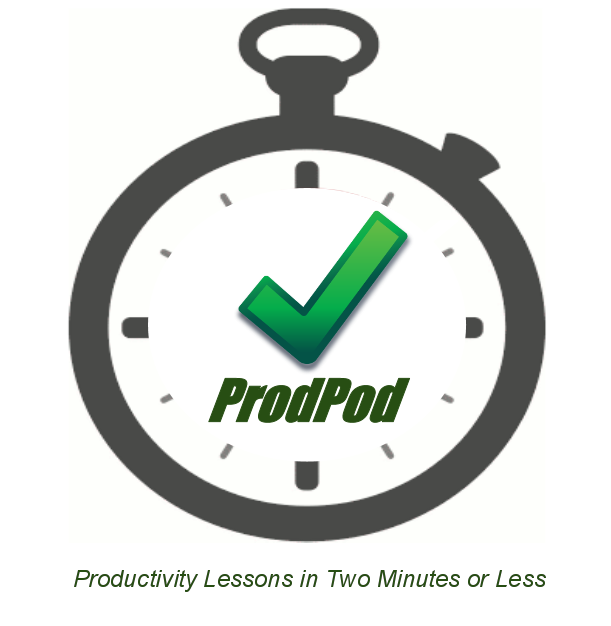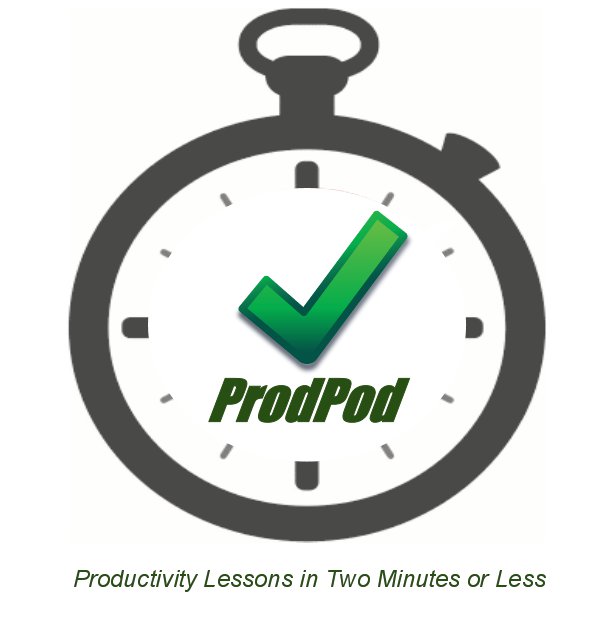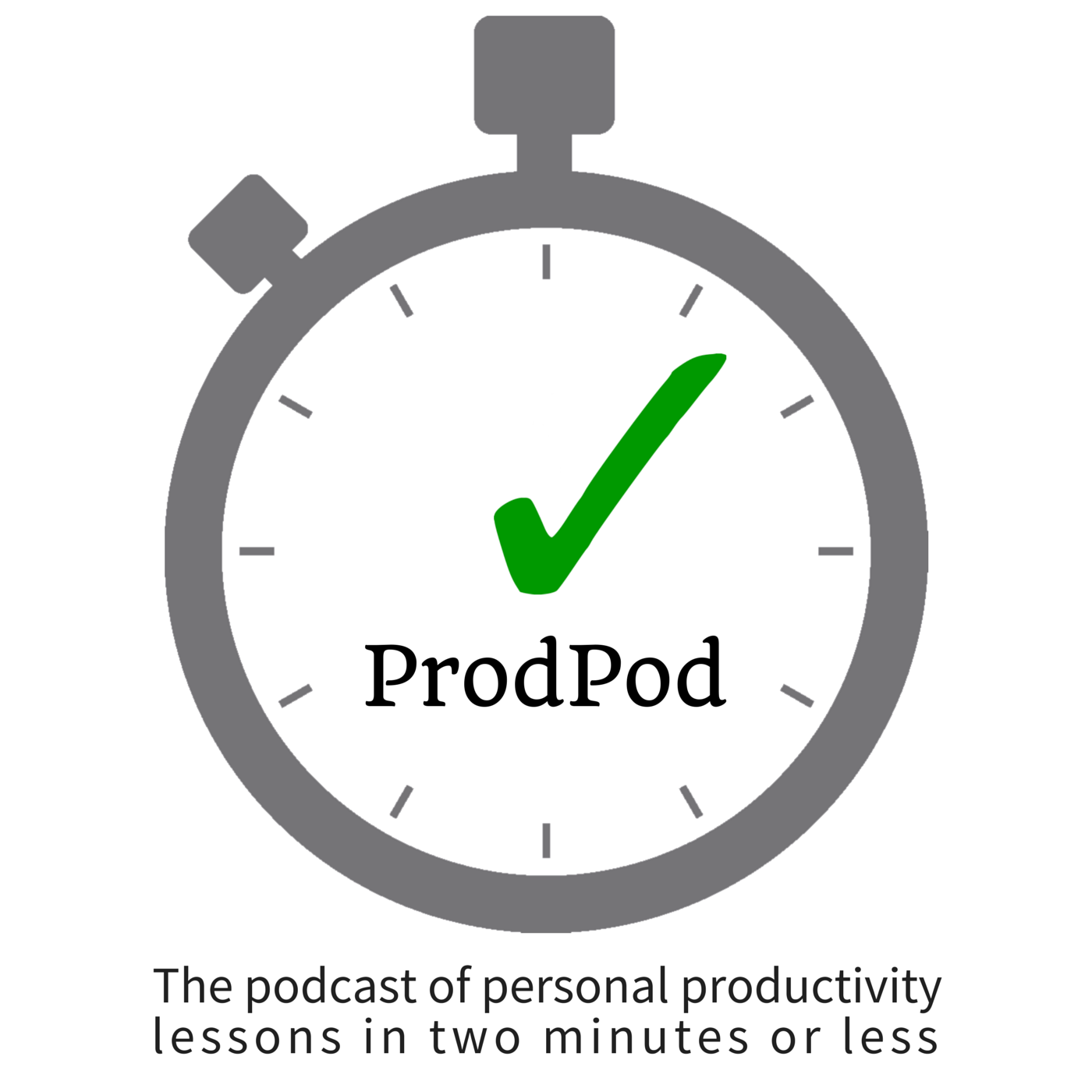Episodes

Tuesday Feb 12, 2013
ProdPod: Episode 53 - "Pull Method" for More Productive Relationships, Part One
Tuesday Feb 12, 2013
Tuesday Feb 12, 2013
In this episode, I introduce you to my relationships management technique I call the "pull method" and explain the first of three phases. In episode 54, I continue with phases two and three of the pull method. Enjoy!
The human mind can keep approximately 150 social connections in their conscious mind at any given time. This median average comes from Dunbar's number named after the British anthropologist, Robin Dunbar, who theorized the oft-cited social metric. I have thousands of people that think they "know" me because they've connected with me in some light touchpoint manner at countless business and social events, hundreds of seminars and presentations I've spoken at, email messages and via Social Media. I'm truly blessed to be able to communicate with some really great people in my professional and personal lives all over the world, and I honor and appreciate every communication I have in my life. However, these online platforms create sometimes a false perception of relationship and genuine community and I want to make sure I'm fostering healthy, productive relationships with the people I truly care about and want to get to know better. So for several years, I've developed a technique to keep myself from being overwhelmed by the overconnectedness of social networking services like Facebook, Twitter and LinkedIn.
I call this technique, the "Pull Method." Here are the basics:
1. First, make an accounting of the people you care about. On a piece of paper with pen (that is, without any address books or electronic aids), wrote down everyone important in your life today; broadly, the categories are family, social and professional connections. Number them. If there are more than 200 contacts, you should likely review the list to *really * consider whether you care about these people or that you just remembered them. Note, this isn't a memory challenge but a practice in determining about whom you really care. Once you've done that, you can move on to the next two phases.
In the next episode, I'll cover phases two and three of my "Pull Method" for more productive relationship. Stay tuned!

Thursday Feb 07, 2013
ProdPod: Episode 52 -- Overflowing Inbox: Try Some Email Overload Relief
Thursday Feb 07, 2013
Thursday Feb 07, 2013
An overflowing inbox is something that we have all probably experienced at some point in our personal and professional lives. Unexpected life circumstances happen and as well we sometimes get lax in our discipline to manage our email traffic on a regular basis. In this episode I give a simple strategy for managing this email overload and some email services that are handy to help manage your email from getting to that point in the first place.
Services mentioned in this episode:
- Unroll.me
- Sanebox (I get a free 5$ account credit for each person that signs up using this link.)
- Boomerang Gmail (I get some kind of credit for you signing up using this link, but I can't figure out what that is!) :-P
- Gmail Valet
The first step is to shut off the email spigot. Create a strategy for sustainably processing your inbox from today forward. Then look at your backlog and attempt to establish a breadcrumb method for dealing with the back email messages. For example, a friend and colleague of mine takes the oldest days worth of email and the last two days' email to process. Doing this every workday along with keeping up with the inbound email today is manageable and in just a few days or weeks's time, you're back to Inbox Zero.
To help with shutting off the email spigot, there's an email service called Unroll.me. It helps you unsubscribe from all those email newsletters you think you should be receiving but they're really just distractions.
Another service is called Sanebox. It automatically filters messages that you don't need to deal with right now so that you can bring those into view when you actually want to address them. I really enjoy being able to train Sanebox and seeing the statistics of how many hours it saves of my time.
Also a favorite service of mine is Boomerang Gmail. It enables you to send email out of view then come back to you at a predetermined date and time. Also Boomerang Gmail is able to schedule an outbound email and has several other really great features so check this one out, for sure.
And finally there's a new service called Gmail Valet. What I understand about the service is that there are real humans who have access to your inbox. And, as new email arrives they review your email to see whether or not it's actionable. If it is, they add it to a task list for you and otherwise move nonactionable items according to your specifications. It's currently free to use in beta!
So there you have it, a strategy for dealing with email overload and some services that can possibly help you from it getting overwhelming in the first place.

Tuesday Feb 05, 2013
Tuesday Feb 05, 2013
The Four-Hour Workweek by Tim Ferriss mentions the Pareto Principle (which I explained in Episode 49), so I figured I would highlight the book's key points in this episode.
The author uses a strategy composed of Definition, Elimination, Automation and then Liberation (the acronym, DEAL) to effectuate his "lifestyle design" concept.
First, Definition boils down to planning. What are your goals, needs and wants?
Next, Elimination is the where he discusses effectiveness over efficiency. And, while I disagree with his bases for the discussion, he effectively discusses using the 80/20 rule here to learn to focus, say "no," and eliminate distractions (for example, the idea of going on an "information diet").
Then, the section on Automation is about tactics to create passive revenue streams; basically, businesses that can run themselves. While this idea is appealing, I say stick to doing what you're passionate about and avoid this get-rich-quick scheme-y thought stream. Either way, I think he adds some great thoughts on hiring a virtual assistant (see ProdPod Episodes 38 through 41 on outsourcing parts of your life for greater productivity)!
Finally, Liberation covers the concept of making your life mobile, if possible.
In a practical sense, I think you'd apply his methodology as Definition, Elimination, Liberation and then Automation, if you're already working full-time for an employer; but that's up to practicalities of finance and time/energy resources available to you.
One key concept that I really enjoyed about the book was his idea of mini-retirements so that you can enjoy the fruits of your labor before you're too old and gray to really enjoy life.
Altogether, the Four-Hour Workweek provides you a framework to understand that your time and life are valuable beyond the 9-5 humdrum. And for that, we can all appreciate ourselves a little more.

Thursday Jan 24, 2013
Thursday Jan 24, 2013
For ProdPod's 50th episode, I had the pleasure of interviewing fitness/nutrition expert, Noelle McKenzie (CEO of Fitness a Way of Life - fitnessawayoflife.com), about some productivity tips for getting your workout / exercise optimized in under 10 minutes! Enjoy!

Tuesday Jan 15, 2013
ProdPod: Episode 49 -- Pareto Principle of Productivity
Tuesday Jan 15, 2013
Tuesday Jan 15, 2013
In this episode I discuss the Pareto Principle of Productivity, so 20% of the next two minutes contains 80% of its productive value! ;-) Enjoy!
At a very young age, we understand that some things are more important than others. As soon as we're born, we learn that the scent of our mothers is important for our survival as the source of our nutrition. As we get a bit older, we realized quickly that mom and dad are more important than the strangers on the street. And as the comparison between objects and concepts get stronger and more complex, we learn to differentiate.
Did you ever hear that 80% of your success comes from 20% of your effort? Inversely, you commit 80% of your effort on outcomes that provide you only 20% of your success.
Have you heard of the 80/20 rule, or better known as the Pareto Principle? This notion comes from economics..to be precise, from an Italian economist Vilfredo Pareto at the turn of the 20th century. He observed that 80% of land (ergo, 80% of its wealth) was owned by 20% of the people, therefore 80% of the wealth was owned by the 20% that were wealthy, and not just in Italy but in many other countries as Pareto did more statistical analysis. This Pareto Principle has been applied in business, health care, mathematics and many other fields, and now it's made its way into personal productivity. I'll take the latitude of stating generally the Pareto Principle for productivity as 80% of your success comes from 20% of your effort. The standard advice therefore is to focus on that 20% then eliminate the rest. And, I mostly reject this notion for anyone who is already working efficiently and effectively. You see, if you've learned a productivity methodology (like GTD) or have your own productivity system designed, especially how to actively process your inputs into actions, delete, delegate, defer, and archive your inputs, you probably won't find much value in the stated corollary to the Pareto Principle. My take on the 80/20 rule has more to do with the over-arching strategy behind your productivity system and making it work better for your already productive life. While most productivity experts speak of efficient, effective effort (the 20%), So, at the project and system level, use 20% of your time to plan AND review to yield the best 80% of your productive DOING time. For example, you make a list, do what's on that list then afterward review what you did. I recommend that 80% of your time should have been spent doing what was on the list, 10% planning, and 10% reviewing. Although 80% is a rough estimate (and you should find out how much planning and review is really good for you), the 80/20 rule gives you a good standard set to know when you're planning and reviewing too little or too much.From Wikipedia: The Pareto principle (also known as the 80-20 rule, the law of the vital few, and the principle of factor sparsity) states that, for many events, roughly 80% of the effects come from 20% of the causes. The Pareto principle was a prominent part of the 2007 bestseller The 4-Hour Workweek by Tim Ferriss. Ferriss recommended focusing one's attention on those 20% that contribute to 80% of the income. More notably, he also recommends 'firing' – refusing to do business with – those 20% of customers who take up the majority of one's time and cause the most trouble.

